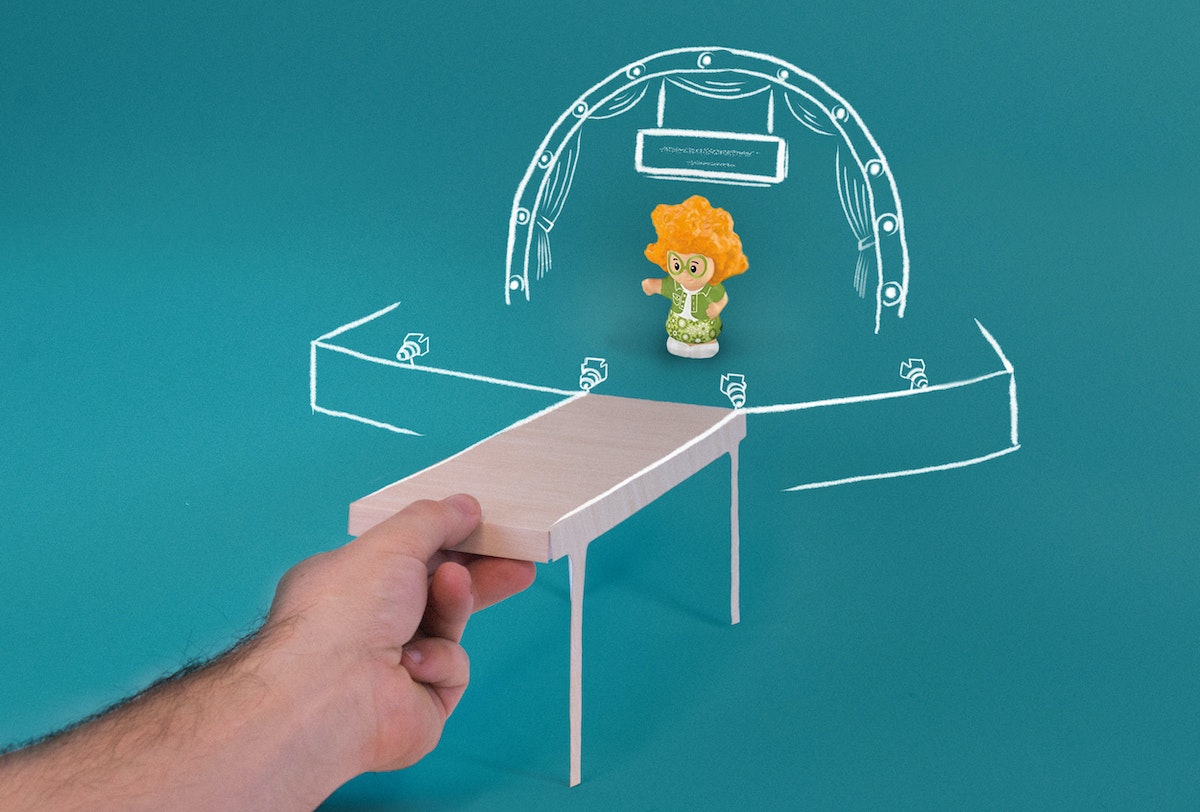Borrow Principles of Theater for Better Design

Two things are required for design success: the right idea, and the ability to convince people of its value. In recent years, designers have become more interested in storytelling to make the case for their solutions. I'd like to take that method a step further, by embracing theater.
The next time you enter a theater, take special note of the black curtains hanging onstage. I can almost promise they’ll be there. Short ones above the stage (called “trim”) obscure the overhead lights, while long ones on the side (called “legs”) hide the backstage performers. Black curtains are a set designer’s secret weapon.
Theater strives for suspension of disbelief. It’s the reason we cry when Romeo and Juliet kill themselves… even though we know the actors aren’t really dead. (They’re not even Romeo and Juliet, for that matter.) It allows an audience to imagine the world of the play far beyond the elements we see in front of us. In our heads, the vivid and colorful streets of Verona extend well behind the black curtains that frame the stage. And all the set designer had to do to create that illusion was hang some fabric.
Designers need to stop making slide decks and start hanging black curtains. As projects become more complex, it becomes impossible to represent an entire concept through words, images, and prototypes alone. Truly innovative designs can’t exist in our present world—they change it into something new. Taking cues from theater is one way to help people suspend their disbelief and bring them inside these new ideas. Here are three ways in:

Embrace Set Design
“Space creates behavior” is a mantra used by interior designers. But there’s a step missing in that equation: Space creates new mindsets, and new mindsets create new behaviors.
When we go to the theater, the curtain rises and we get our first glimpse into the world of the play. It’s the moment when an audience is asked to leave the reality of the theater (velvet seats, half-finished wine, smartphones, etc.) and enter an alternative reality crafted by the show.
Boardrooms are not a good place for achieving that effect. If we want people to engage with unprecedented ideas, we need to transport them out of their current reality. It’s absurd to assume that people will think differently when they are sitting in the same chair, at the same table, staring at the same drop-down projection screen they see everyday.
Even simple changes to a physical environment can drastically shift the way an audience (in this case, clients, investors, etc.) will approach a meeting.
Consider:
Lighting—a darkened room creates a sense of possibility and wonder.
The unexpected reveal—bring out a hidden element part-way through the meeting.
Sound—background noise or music helps guide people to an emotional state before, during, and after the show.

Play the Role of Director
Another way to shift a viewer’s mindset is to go at it directly. Direct them, as if they were an actor, and give them a new role to play and a new way to think.
At IDEO, mid-project meetings are often the most crucial point of contact with our clients. In those meetings, they must assess the opportunities we’ve uncovered through research, and decide which ones to pursue. If the audience defaults to their standard decision-making metrics, engineers will choose the most technically-feasible option, while the CFO might choose the most cost-effective path forward. Innovative ideas are difficult to judge in this way, so they can easily be left behind.
But asking these same people to make decisions from a different perspective can open up the room to new possibilities, and create excitement around the more difficult to imagine, yet more innovative ideas.
Here, you accomplish two things. First, by having them embody a new viewpoint, they are forced to drop their default mode of interaction and pick up a new way of thinking. Second, because the exercise feels inherently contrived, it offers participants a mental safety net. It’s not real—it’s make believe. When people let their guard down, that’s often when the real insights emerge.
Think about:
Directed actions—as soon as people are required to do something, they leave the passive audience state.
Physical movement—if people are required to stand up and move around, they automatically engage in a more meaningful way.
Assigning new roles—if people are required to observe and respond as someone other than themselves, they will come at the experience from a position of empathy.

Be a Reviewer
Anytime you engage with an unprecedented experience, the take-aways are not always clear. In the world of theater, new audience members might walk out of a show thinking, “I loved it!” or “I was bored!” or “I was bawling, but I’m not totally sure why.” A good theatrical experience should elicit some type of emotional reaction from the audience, but people may not have the necessary vocabulary to analyze it. Good reviewers can help translate the experience for the rest of the world and direct attention to what is important or meaningful.
In design, crafting the takeaway message becomes a crucial exercise. It’s important to tell people how ideas and concepts can translate back to their real-world experience. If the most brilliant concepts can’t be understood beyond the context of a highly theatricalized presentation, there’s no way it will ever have impact in the world.
Consider:
A summary—what's the essence of what they just experienced?
Analysis—what's the deeper meaning or purpose this connects to?
Drafting a plan—what actions should take place as a result of the experience?
Innovation is a tricky business. As designers, we are tasked with creating unprecedented experiences that help shift the world into the future, yet we are stuck discussing them in the present. Creating innovative work is not enough. We must create innovative ways of sharing that work to help audiences suspend their disbelief and imagine the future that might exist.
Illustrations by Megan Crabtree.


Subscribe to the IDEO newsletter
.jpg)



